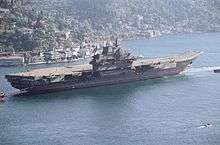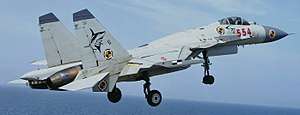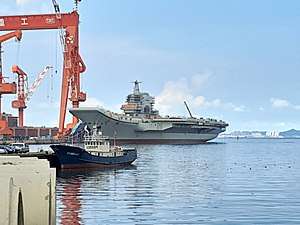Chinese aircraft carrier programme
The Chinese aircraft carrier programme, operated by the People's Liberation Army Navy (PLAN) of China, currently has a single combat-ready aircraft carrier, the Liaoning, with a second and third reportedly under construction.[1]
Since the 1970s, the People's Liberation Army Navy (PLAN) had expressed interest in operating an aircraft carrier as part of its blue water aspirations.[2] In 2011, People's Liberation Army Chief of the General Staff Chen Bingde confirmed that China was constructing at least one aircraft carrier.[3] In September 2012, China's first aircraft carrier, Liaoning, was commissioned. Four years later, in November 2016, it was reported that Liaoning was combat ready. China has confirmed that it is constructing a second carrier that will be built entirely with indigenous Chinese designs. Similar to Liaoning, China's second carrier will also use a ski jump for takeoff.[4]
Since 1985, China has acquired four retired aircraft carriers for study, the Australian HMAS Melbourne and the ex-Soviet carriers Minsk, Kiev and Varyag. Reports stated that up to two 60,000-ton Type 001A aircraft carriers based on Varyag were due to be started by 2015.[5]
Acquisition of retired aircraft carriers
Chinese shipyards have gained some exposure to carrier design with the acquisition of retired hulls such as the Australian HMAS Melbourne acquired in 1985. The carrier was not dismantled for many years and according to some reports she was not completely broken up until 2002.[6]
Through various ventures, China has also purchased the ex-Soviet carriers Minsk[7] and Kiev. These carriers have become floating amusement parks for tourists.
There had been other plans to purchase foreign second-hand carriers in the past. For example, a possible deal between China and France for the sale of the Clemenceau fell through in 1997.[8]
ex-HMAS Melbourne
Chinese reverse-engineered a land-based replica of the steam catapult and landing system from that of HMAS Melbourne, and a J-8IIG was used to conduct take-off and landing trials on the land-based flight deck in April 1987, which was not finally confirmed officially until 27 years later in April 2014 by CCTV-13.[9] Both the take-off and landing were conducted on the same day, and the test pilot was PLANAF pilot Li Guoqiang (李国强).[10] The experience gained was applied to the Shenyang J-15.[11]
ex-Kiev
Several days after ex-Varyag went on its first-sea-trial in August 2011, ex-Kiev welcomed guests in its new role as a luxury hotel with a £9.6 million ($15.6 million) refit. The owners believe that China's naval ambitions as well as a general curiosity about aircraft carriers will result in public interest.[12]
Liaoning (Type 001)

The 67,500 ton ex-Soviet aircraft carrier Varyag (Kuznetsov class), which was only 70% completed and floating in Ukraine, was purchased through a private Macau tourist venture in 1998. Following her troublesome tow to Dalian shipyard, the carrier underwent a long refit. Varyag had been stripped of any military equipment as well as her propulsion systems prior to being put up for sale. In 2007 there were news reports that she was being fitted out to enter service.[5][13]
On 10 August 2011, it was announced that the refurbishment of Varyag was complete, and that it was undergoing sea trials.[14][15]

On 14 December 2011, DigitalGlobe, an American Satellite imaging company, announced that while scouring through pictures taken December 8, they had discovered the retrofitted Varyag undergoing trials, DigitalGlobe further stated that their images captured the ship in the Yellow Sea where it operated for 5 days.[16]
In September 2012, it was announced that this carrier would be named Liaoning, after Liaoning Province of China. On 23 September 2012, Liaoning was handed over to the People's Liberation Army Navy, but was not yet in active service.[17]
In November 2012, the first landing was successfully conducted on Liaoning with Shenyang J-15.[18]
Acquisition of designs
In addition to the acquisition of retired aircraft carriers of foreign navies, the PLAN has been actively purchasing foreign aircraft carrier designs as well. One such example was its effort to purchase the blueprints for proposed conventional take off/landing ships from Empresa Nacional Bazan of Spain; the 23,000 ton SAC-200 and the 25,000 ton SAC-220 designs. Negotiations started between 1995 – 1996 but did not result in any purchase. However, the Spanish firm was paid several million US dollars in consulting fees, indicating the probable transfer of some design concepts.[8]
Early plans
The first official plan of PLAN aircraft carrier development dated back on March 31, 1987 when the Commission of Science, Technology and Industry for National Defense approved the plan on the aircraft carrier and the next generation nuclear submarine for PLAN advocated and submitted by the then commander-in-chief of PLAN, Liu Huaqing. The original plan was to be progressed in stages, with basic research to be completed by the end of the 7th 5-year plan, and development of the platform and aircraft to be completed by the end of the 8th 5-year plan. By 2000, construction was to begin when ordered.
To prepare the commanders needed for the future aircraft carriers, the Central Military Commission approved the program of training jet fighter pilots to be future captains in May 1987, and the Guangzhou Naval Academy (Chinese: 广州舰艇学院; pinyin: Guǎngzhōu jiàntǐng xuéyuàn) was selected as the site.[8]
However, Liu Huaqing’s plan proved to be too ambitious as the domestic Chinese industry at the time could not meet the goal demanded by the plan. As a result, the plan was drastically scaled back to basic research level and the date for an aircraft carrier entering PLAN service was postponed and eventually put on hold. In the meantime, pilot candidates for warship captain training was also altered, with candidates switched to ship-borne helicopter pilots, because it was considered that naval helicopter pilots with much more ship-borne aviation experience would be better prepared than the land-based jet fighter pilots who lack ship-borne aviation experience.
Current status
In mid-2007, Chinese domestic sources revealed that China had purchased a total of four sets of aircraft carrier landing systems from Russia[19] and this was confirmed by Russian manufacturers. However, experts disagreed on the usage of these systems: while some have claimed that it is a clear evidence of the construction of an aircraft carrier, others claim these systems are used to train pilots for a future ship. In August, 2008, Mr. Huang Qiang (黄强), the speaker of the Commission of Science, Technology and Industry for National Defense announced to the public at a news conference that China had mastered all of the technologies for an aircraft carrier, and would build aircraft carriers in the future when the time was deemed right.
According to the Nippon News Network (NNN), research and development on the planned carriers is being carried out at a military research facility in Wuhan. NNN states that the actual carriers will be constructed at Jiangnan Shipyard in Shanghai.[20] Kanwa Intelligence Review reports that the second carrier to be constructed will likely be assigned to Qingdao.[21]
According to a February 2011 report in The Daily Telegraph, the Chinese military has constructed a concrete aircraft carrier flight deck to use for training carrier pilots and carrier operations personnel. The deck was constructed on top of a government building near Wuhan (Wuhan Technical College of Communication campus next to Huangjiahu).[22]
On 7 June 2011, People's Liberation Army Chief of the General Staff Chen Bingde confirmed that China was constructing its own aircraft carrier. He stated he would provide no further details until it was complete.[3]
On 30 July 2011, a senior researcher of the Academy of Military Sciences said China needed at least three aircraft carriers. "If we consider our neighbours, India will have three aircraft carriers by 2014 and Japan will have three carriers by 2014, so I think the number (for China) should not be less than three so we can defend our rights and our maritime interests effectively." General Luo Yuan.[23] In July 2011, a Chinese official announced that two aircraft carriers were being built at the Jiangnan Shipyard in Shanghai.[24][25] On 21 May 2012, Taiwan's intelligence chief Tsai Teh-sheng told the Legislative Yuan that the PLA Navy plans to build two carriers, scheduled to start construction in 2013 and 2015 and launch in 2020 and 2022 respectively.[26] On 24 April 2013, Chinese Rear Admiral Song Xue confirmed that China will build more carriers and these will be larger and will carry more fighter-planes than Liaoning.[27]
Type 001A

In December 2013, China's Central Military Commission told Duowei News it planned to commission two Liaoning-pattern aircraft carriers by 2020, designated as Type 001A. Contracts have been awarded to China Shipbuilding Industry Corporation to build the two carriers. The cost is projected to be US$9 billion.[28] A waist catapult could be fitted to one or both vessels to facilitate airborne early warning aircraft operation and air control. Presently Liaoning combines unassisted ski-jump launched aircraft with helicopters for anti-submarine and air defense operations. Construction began in 2013 and the ship was launched in April 2017.
On 31 December 2015, a spokesman of the Chinese Ministry of Defense confirmed that China is designing and building its second aircraft carrier.[29][30]
The 001A is a conventionally powered ski jump carrier with a displacement of around 70,000 tonnes.[31] It is likely to be powered by oil-fired boilers and steam turbines, though previously there has been speculation that it could be gas-turbine propelled.[32] There are some evident differences from the Soviet built Liaoning.
Type 002
The second Chinese-designed aircraft carrier, known as Type 002, is to be an entirely different design than Types 001 (Liaoning) It will have a displacement of around 85,000 tonnes.[31]
In 2015, media reports stated that both an EMALS and a steam-powered catapult were constructed at the Huangdicun naval base for testing; this is thought to indicate that the Type 002 class as well as future PLAN carriers could possibly be CATOBAR carriers.[33]
The construction of the first Type 002 class aircraft carrier started in February 2016.[34]
Type 003
The Type 003 is planned to be larger than the Type 002, and also feature nuclear propulsion,[35] which could power weapons like lasers and railguns.[36] It is believed that there are two ships of the class are being built in Dalian Shipyard and Jiangnan Shipyard simultaneously,[35] and that construction started in December 2017.[37]
Development of carrier-based aircraft
China initially intended to acquire Russian Sukhoi Su-33 carrier-based aircraft to be operated from its aircraft carriers.[38] However, China later developed the Shenyang J-15 as a derivative of the Su-33,[39] featuring Chinese technology and avionics from the J-11B program.[39]
On 25 November 2012, it was announced that at least two Shenyang J-15s had successfully landed on Liaoning.[18][40] The pilot credited with having achieved the first landing was Dai Mingmeng (戴明盟).[41] According to Chinese media reports, the J-15 cannot take off from Liaoning with a full weapons and fuel load exceeding 12 tons, being unable to get off the carrier’s ski jump ramp.[42] The Shenyang J-31 is a fifth generation fighter aircraft being developed by China that may in future be adopted for carrier use.
There are unconfirmed reports of a J-15A catapult compatible fighter being tested on an Electromagnetic (EMALS type) catapult. This is thought to likely have occurred at the Huangdicun facility.[43]
The South China Morning Post reported on July 6th 2018 that China is developing a variant of the FC-31 as an alternate carrier operational jet. [44]
List of carriers
| Hull number | Name | Class | Builder | Launched | Commissioned | Home port | Status |
|---|---|---|---|---|---|---|---|
| 16 | 辽宁 Liaoning |
Type 001 | Mykolaiv Shipyard (Hull) Dalian Shipyard (Refit) |
December 1988 | September 2012[45] | Jianggezhuang Naval Base[46] | Refitting[47] |
| 17 | tbd | Type 001A | Dalian Shipyard | April 2017 | Estimated 2019[48] | Sea trials[49] | |
| tbd | tbd | Type 002 | Jiangnan Shipyard | Estimated 2020 | Estimated 2023 | Under construction | |
| tbd | tbd | Type 003 | Jiangnan Shipyard | Under construction[35] | |||
| tbd | tbd | Type 003 | Dalian Shipyard | Under construction[35] | |||
| tbd | tbd | Type 004 | Dalian Shipyard | Planned | |||
See also
References
- ↑ https://www.defensenews.com/naval/2018/01/23/no-slowdown-for-chinas-navy-aspirations/
- ↑ Wang Jianfen; Nie Ligao (23 March 2009). "Japan defense minister's China visit a sign of warming relations". Chinadaily.com.cn. Archived from the original on 1 January 2018. Retrieved 10 September 2018.
- 1 2 "PLA Chief Confirms Vessel Is 'Under Construction'". Global Times. 8 June 2011.
- ↑ ChinaPower. "How does China's first aircraft carrier stack up?". Center for Strategic and International Studies. Retrieved 29 Dec 2016.
- 1 2 Minemura, Kenji (31 December 2008), China to start construction of 1st aircraft carriers next year, Asahi Shimbun, archived from the original on 26 May 2009, retrieved 30 May 2015
- ↑ Hobbs, Commander David (October 2007). "HMAS Melbourne (II) – 25 Years On". The Navy. 69 (4): 5–9. ISSN 1322-6231.
- ↑ "Former Soviet aircraft carrier sold in China for $16mln". Sputnik International. 31 May 2006. Retrieved 30 May 2015.
- 1 2 3 Storey, Ian; Ji, You (Winter 2004). "China's Aircraft Carrier Ambitions: Seeking Truth from Rumors". Naval War College Review. Archived from the original on December 12, 2006. Retrieved 30 May 2015.
- ↑ "J-8IIG". Retrieved April 22, 2014.
- ↑ "J-8IIG trials". Retrieved April 22, 2014.
- ↑ "Knowledge gained from J-8 used on J-15". Retrieved November 7, 2013.
- ↑ "China launches second aircraft carrier after a £9.6m refit... as a luxury hotel". Daily Mail. London. 11 August 2011. Retrieved 30 May 2015.
- ↑ Rosamond, Jon (November 2007). "China completes joint exercise with UK aircraft carrier". Jane's Navy International. p. 6.
- ↑ Hille, Kathrin (10 August 2011). "China's first aircraft carrier takes to the sea". The Financial Times. Retrieved 30 May 2015. (subscription required)
- ↑ "China's first aircraft carrier begins sea trials". CBC News. 10 August 2011. Retrieved 30 May 2015.
- ↑ "US satellite snaps China's first aircraft carrier at sea". The Guardian. London. 15 December 2011. Retrieved 30 May 2015.
- ↑ "China navy takes delivery of first aircraft carrier". 23 September 2012. Retrieved 30 May 2015.
- 1 2 我航空母舰顺利进行歼—15飞机起降飞行训练. 新华网 (in Chinese). 北京. 25 November 2012. Retrieved 30 May 2015.
- ↑ Bodeen, Christopher (6 March 2009), "Speculation Grows on China Aircraft Carrier Plans", abcnews, Associated Press, archived from the original on 7 May 2009, retrieved 30 May 2015
- ↑ 中国の国産空母の建造、最前線を報告 [China's indigenous aircraft carrier construction, the frontline report] (in Japanese), 10 January 2010, retrieved 30 May 2015 Google translation
- ↑ "Long-Range SAMS Deployed In Qingdao". Kanwa Intelligence Review. 10 April 2010.
- ↑ Harding, Thomas (7 February 2011), Concrete Evidence Of China's Naval Ambitions, London: The Daily Telegraph, retrieved 30 May 2015
- ↑ "China needs at least three aircraft carriers: general". Spacewar. 30 July 2011. Retrieved 30 May 2015.
- ↑ Gertz, Bill (2 August 2011). "China begins to build its own aircraft carrier". Washington Times. p. 1. Retrieved 30 May 2015.
- ↑ Blanchard, Ben; Lim, Benjamin (27 July 2011). "China boosts naval power with carrier program: sources". Reuters. Retrieved 30 May 2015.
- ↑ "Taiwan Says China To Build Two Aircraft Carriers". Channel NewsAsia. 22 May 2012.
- ↑ Sweeney, Pete (24 April 2013). "China to build second, larger carrier: report". Reuters. Retrieved 30 May 2015.
- ↑ "New aircraft carriers to be built in Dalian and Shanghai: source". WantChinaTimes.com. 11 December 2013. Archived from the original on 18 April 2015. Retrieved 30 May 2015.
- ↑ "中国正在自主开展设计和建造第二艘航空母舰". 新华网. 2015-12-31.
- ↑ "China building second aircraft carrier". Xinhuanet. 2016-12-31.
- 1 2 "China Reveals Launch Date of New Aircraft Carriers". Sputnik International. 13 February 2017.
- ↑ "Further progress made on China's Type 001A carrier". IHS Jane's Defence Weekly. 26 September 2016. Retrieved 12 November 2016.
- ↑ "CHINA'S NEW CARRIER GETS A SKI RAMP". Popular Science. 5 May 2016. Retrieved 12 November 2016.
- ↑ "China building third aircraft carrier, says report". IHS Jane's. 24 February 2017. Retrieved 24 February 2017.
- 1 2 3 4 Mizokami, Kyle (7 September 2018). "Inside China's Plan to Build the Second-Biggest Aircraft Carrier Fleet in the World". Foxtrot Alpha. Jalopnik. Retrieved 7 September 2018.
- ↑ Lin, Jeffrey Lin; Singer, P.W. (16 August 2017). "China's making major progress with its aircraft carrier tech". Popular Science. Retrieved 11 November 2017.
- ↑ Seidel, Jamie (23 April 2018). "Here's what we know about China's newest aircraft carriers". news.com.au. Retrieved 19 June 2018.
- ↑ "China to Buy Su-33 Carrier-Based Fighters from Russia?". Defenseindustrydaily.com. 26 March 2009. Retrieved 30 May 2015.
- 1 2 Fulghum, David A. "New Chinese Ship-Based Fighter Progresses". Article. Aviation Week. Retrieved 27 April 2011.
- ↑ "China lands first fighter jet on aircraft carrier". 3 News NZ. Associated Press. 26 November 2012. Retrieved 30 May 2015.
- ↑ 戴明盟:着舰成功首飞第一人. 钱江晚报 (in Chinese). 杭州. 24 November 2012. Retrieved 30 May 2015.
- ↑ Minnick, Wendell (28 September 2013). "Chinese Media Takes Aim at J-15 Fighter". Defense News. Retrieved 21 July 2015.
- ↑ http://plarealtalk.com/2016/11/09/chinese-navy-catapult-and-j-15a/. Retrieved 12 November 2016. Missing or empty
|title=(help) - ↑ https://www.scmp.com/news/china/diplomacy-defence/article/2153803/china-working-new-fighter-jet-aircraft-carriers-replace/. Retrieved 6 July 2018. Missing or empty
|title=(help) - ↑ https://www.washingtonpost.com/world/chinas-first-aircraft-carrier-the-liaoning/2012/09/25/06cd105c-0716-11e2-a10c-fa5a255a9258_gallery.html
- ↑ Ritsick, Colin (19 August 2018). "Here Is Every One Of The Active Aircraft Carriers In The World". militarymachine.com. Retrieved 7 September 2018.
- ↑ Liu Zhen (28 August 2018). "China's Liaoning aircraft carrier gets brand new command centre". South China Morning Post. Retrieved 7 September 2018.
- ↑ https://www.cnbc.com/2018/04/25/chinas-homegrown-aircraft-carrier-type-001a-will-start-sea-trials.html
- ↑ https://www.cnbc.com/2018/04/25/chinas-homegrown-aircraft-carrier-type-001a-will-start-sea-trials.html
External links
- China / Aircraft Carrier Project, GlobalSecurity.org
